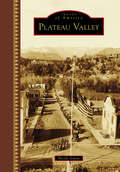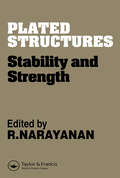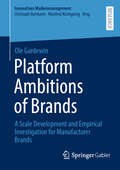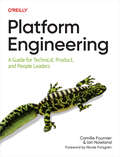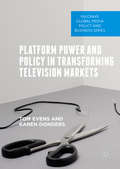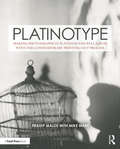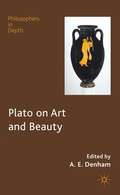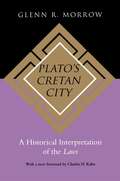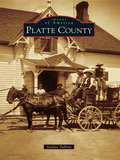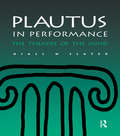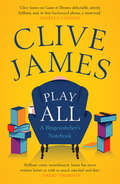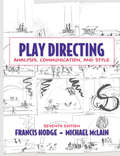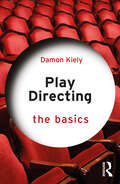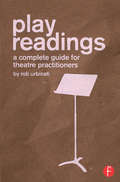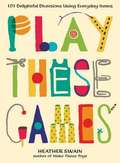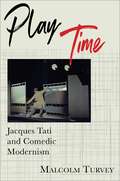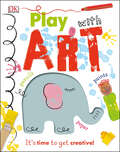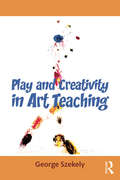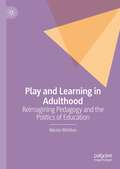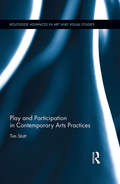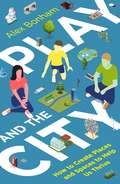- Table View
- List View
Plateau Valley (Images of America)
by Nicole InmanKnown to the Ute Indians as Thigunawat (Home of the Departed Spirits), the Grand Mesa has been a beacon for adventurous souls for hundreds of years. In 1776, the Dominguez-Escalante Expedition crossed through the area while searching for a route that would become the Old Spanish Trail. In 1881, with the removal of the Ute Indians to reservation lands, homesteaders arrived and began settling in Plateau Valley. Nestled along the Grand Mesa, the valley is home to the communities of Collbran, Plateau City, Mesa, and Molina. Many of the historic buildings are still in use, and the Community Church Building has been designated a historic landmark. Recreational opportunities abound, both within the valley and nearby on the Grand Mesa. Camping, fishing, hiking, hunting, skiing, snowmobiling, and snowshoeing are among the favorites.
Plated Structures: Stability and strength
by R. NarayananFirst published in the 1983. This is third book of a planned set of volumes on the stability and strength of structures. The collapse a few years ago of four large box girders during erection precipitated a considerable research effort in many countries on the various design aspects of plated structures (such as box girders and plate girders). This book is addressed to structural designers and post-graduate students, a fundamental knowledge of structural mechanics is taken for granted; nevertheless, sufficient introductory material is included in each chapter to make the subject matter easily readable. This volume contains eight chapters, all of which are written by persons who have made notable contributions to the relevant subject area. The first four chapters are devoted to various aspects of the design of a plate girder and concentrate largely on the associated stability problems in shear. The four remaining chapters are largely concerned with stability problems in compression, such as those met in box girder flanges and ship hulls. Chapter 8 also highlights some of the complexities of interaction between different stresses. Thus the book covers a wide range of topics of relevance to both the designer and the student.
Platform Ambitions of Brands: A Scale Development and Empirical Investigation for Manufacturer Brands (Innovatives Markenmanagement)
by Ole GardewinThe platform economy is gaining increasing importance. Digital platforms can be found in more and more areas of consumers' daily lives. One area particularly affected by this is online shopping, which is becoming increasingly popular. Large online retailers have achieved monopolistic positions, and the majority of online shopping takes place on their marketplaces. This presents significant challenges for manufacturer brands. Recently, some of them have started operating their own platforms to counteract the risks within the platform economy, the so-called Brand Flagship Platforms. This book not only presents the development of the first empirical measurement scale for assessing the benefit dimensions of these Brand Flagship Platforms but also takes it a step further by analyzing the behavioral impact of these platforms on consumers’ attachment to the respective brands and, ultimately, on their purchasing behavior. This serves both researchers and practitioners in assessing the impact of digital platforms on their own brand.
Platform Engineering
by Camille Fournier Ian NowlandUntil recently, infrastructure was the backbone of organizations operating software they developed in-house. But now that cloud vendors run the computers, companies can finally bring the benefits of agile custom-centricity to their own developers. Adding product management to infrastructure organizations is now all the rage.But how's that possible when infrastructure is still the operational layer of the company?This practical book guides engineers, managers, product managers, and leaders through the shifts required to become a modern platform-led organization. You'll learn what platform engineering is "and isn't" and what benefits and value it brings to developers and teams. You'll understand what it means to approach your platform as a product and learn some of the most common technical and managerial barriers to success.With this book, you'll:Cultivate a platform-as-product, developer-centric mindsetLearn what platform engineering teams are and are notStart the process of adopting platform engineering within your organizationDiscover what it takes to become a product manager for a platform teamUnderstand the challenges that emerge when you scale platformsAutomate processes and self-service infrastructure to speed development and improve developer experienceBuild out, hire, manage, and advocate for a platform team
Platform Power and Policy in Transforming Television Markets (Palgrave Global Media Policy and Business)
by Karen Donders Tom EvensThis book seeks to investigate ‘platform power’ in the multi-platform era and unravels the evolution of power structures in the TV industry as a result of platformisation. Multiple TV platforms and modes of distribution are competing–not necessarily in a zero-sum game–to control the market. In the volume, the contributors work to extend established ‘platform theory’ to the TV industry, which has become increasingly organised as a platform economy. The book helps to understand how platform power arises in the industry, how it destabilises international relations, and how it is used in the global media value chain. Platform Power and Policy in Transforming Television Markets contributes to the growing field of media industry studies, and draws on scholarly work in communication, political economy and public policy whilst providing a deeper insight into the transformation of the TV industry from an economic, political and consumer level. Avoiding a merely legal analysis from a technology-driven perspective, the book provides a critical analysis of the dominant modes of power within the evolving structures of the global TV value chain.
Platform Urbanism: Negotiating Platform Ecosystems in Connected Cities (Geographies of Media)
by Sarah BarnsThis book reflects on what it means to live as urban citizens in a world increasingly shaped by the business and organisational logics of digital platforms. Where smart city strategies promote the roll-out of internet of things (IoT) technologies and big data analytics by city governments worldwide, platform urbanism responds to the deep and pervasive entanglements that exist between urban citizens, city services and platform ecosystems today. Recent years have witnessed a backlash against major global platforms, evidenced by burgeoning literatures on platform capitalism, the platform society, platform surveillance and platform governance, as well as regulatory attention towards the market power of platforms in their dominance of global data infrastructure. This book responds to these developments and asks: How do platform ecosystems reshape connected cities? How do urban researchers and policy makers respond to the logics of platform ecosystems and platform intermediation? What sorts of multisensory urban engagements are rendered through platform interfaces and modalities? And what sorts of governance challenges and responses are needed to cultivate and champion the digital public spaces of our connected lives.
Platinotype: Making Photographs in Platinum and Palladium with the Contemporary Printing-out Process (Contemporary Practices in Alternative Process Photography)
by Pradip Malde Mike WarePlatinotype: Making Photographs in Platinum and Palladium with the Contemporary Printing-out Process describes the mechanisms and chemistry of platinum/palladium printing in safe and practical ways. Clearly presented formulae allow the printer to work with platinum, palladium, or varying combinations of both. The printed-out image appears fully during exposure, and only requires simple and safe steps for clearing to a stable, archival state. The authors explain what makes the image, how all necessary components are prepared and used, and the kind of paper and negative needed to make prints. More than just a technical manual, the book underscores the authors' belief that printing is a creative, scientific, and philosophic way of working. The book presents an outstanding collection of prints by over 40 artists, all made with this printing-out process. The artists' notes and comments offer insights into their methods and thinking, and a large number of full-page reproductions serve as a valuable reference for the aspiring printer. The book includes: A list of supplies and equipment A detailed chemical glossary A Quick-start section in the Preface Summary sheets and workflows for each step of the process Instructions for making traditional negatives with Pyro PMK and digital negatives Explanation of the chemistry and dynamics of paper, and how to use buffered papers Instructions for controlling hydration processes and humidity Instructions for preparing each chemical solution needed for the process Discussion about the aesthetics of the platinum/palladium print Explanation of the relationships between light, image, and expression A detailed troubleshooting list Recommendations from conservators about processing, handling, and conservation Contemporary artists using the printing-out platinum/palladium process. Learning how to make platinum/palladium prints has been cloaked in a mystique of difficulty. Platinotype presents the process as a set of clearly explained and defined steps. Like other books in the series, Platinotype is a detailed and inspiring manual, accessible to both novices and experts, and illustrative of the contemporary arts.
Plato on Art and Beauty
by A. E. DenhamThis unique collection of essays focuses on various aspects of Plato's Philosophy of Art, not only in The Republic , but in the Phaedrus, Symposium, Laws and related dialogues. The range of issues addressed includes the contest between philosophy and poetry, the moral status of music, the love of beauty, censorship, motivated emotions.
Plato's Cretan City: A Historical Interpretation of the Laws
by Glenn R. MorrowPlato's Cretan City is a thorough investigation into the roots of Plato's Laws and a compelling explication of his ideas on legislation and social institutions. A dialogue among three travelers, the Laws proposes a detailed plan for administering a new colony on the island of Crete. In examining this dialogue, Glenn Morrow describes the contemporary Greek institutions in Athens, Crete, and Sparta on which Plato based his model city, and explores the philosopher's proposed regulations concerning property, the family, government, and the administration of justice, education, and religion. He approaches the Laws as both a living document of reform and a philosophical inquiry into humankind's highest earthly duty.
Platte County (Images of America)
by Starley TalbottThe North Platte River that flows through a portion of Platte County, Wyoming, lent its name to the new county carved from Laramie County in 1911. Prior to the late 1800s, with the exception of Native Americans, trappers, and some ranchers, few people chose to remain in the territory. Travelers who crossed the windswept prairies followed trails headed for the lush farmlands of Oregon or the goldfields of California and the Black Hills. In 1883, the Wyoming Development Company began an irrigation project that brought an influx of farmers to the promising new acreages around Wheatland, the town that became the county seat. The arrival of the railroad in the late 1800s brought more farmers, ranchers, and miners to the area that would become Platte County. New residents established dozens of communities with schools, churches, and businesses. The remaining viable towns are Wheatland, Glendo, Hartville, Guernsey, and Chugwater. This book covers the history of these towns, and the vanished ones, along with the rural areas of Platte County.
Plautus in Performance: The Theatre of the Mind (Greek And Roman Theatre Archive Ser. #Vol. 2.)
by Niall W. SlaterPlautus was Ancient Rome's greatest comic playwright, Shakespeare drew heavily on his plots, and his legacy is prevalent throughout modern drama. In this expanded edition of his successful book, one of America's foremost Classical scholars introduces performance criticism to the study of Plautus' ancient drama. In addition to the original detailed studies of six of the dramatists's plays, the methodology of performance criticism, the use of conventions, and the nature of comic heroism in Plautus, this edition includes new studies on: * the induction into the world of the play * the scripted imitation of improvisation * Plautus's comments on his previous work * the nature of 'tragicomedy'.
Play All: A Bingewatcher's Notebook
by Clive James&“A loving and breezy set of essays&” on today&’s most addictive TV shows from &“an incisive and hilarious critic&” (Slate). Television is not what it once was. Award-winning author and critic Clive James spent decades covering the medium, and witnessed a radical change in content, format, and programming, and in the very manner in which TV is watched. Here he examines this unique cultural revolution, providing a brilliant, eminently entertaining analysis of many of television&’s most notable twenty-first-century accomplishments and their not always subtle impact on modern society—including such acclaimed serial dramas as Breaking Bad, The West Wing, Mad Men, and The Sopranos and the comedy 30 Rock. With intelligence and wit, James explores a television landscape expanded by cable and broadband and profoundly altered by the advent of Netflix, Amazon, and other cord-cutting platforms that have helped to usher in a golden age of unabashed binge-watching. &“James loves television, he loves the winding stories it tells and that we share them together. Play All is a late love letter to the medium of our lives.&”—Sunday Times &“Large-brained and largehearted, and written with astonishing energy.&”—The New York Times Book Review &“Witty and insightful musing on popular and critically acclaimed series of the past two decades.&”—Publishers Weekly
Play Directing: Analysis, Communication, and Style
by Michael Mclain Francis HodgePlay Directing describes the various roles a director plays, from selection and analysis of the play, to working with actors and designers to bring the production to life.
Play Directing: The Basics (The Basics)
by Damon KielyPlay Directing: The Basics introduces theatre students to a step-by-step process for directing plays, including advice on devising. Beginning with a historical overview of directing, this book covers every aspect of the director’s job from first read to closing night. Practical advice on finding plays to produce, analysing scripts, collaborating with the design team, rehearsing with actors, devising company creations, and opening a show are peppered with advice from working professionals and academic directors. A practical workbook, short exercises, helpful websites, and suggested reading encourage readers towards a deeper study of the art of directing. This book empowers high school and early college students interested in theatre and directing to find their own voice, develop a practice, and refine their process.
Play Readings: A Complete Guide for Theatre Practitioners
by Rob UrbinatiPlay Readings: A Complete Guide for Theatre Practitioners demystifies the standards and protocols of a play reading, demonstrating how to create effective and evocative readings for those new to or inexperienced with the genre. It examines all of the essential considerations involved in readings, including the use of the venue, pre-reading preparations, playwright/director communication, editing/adapting stage directions, casting, using the limited rehearsal time effectively, simple "staging" suggestions, working with actors, handling complex stage directions, talkbacks, and limiting the use of props, costumes, and music. A variety of readings are covered, including readings of musicals, operas, and period plays, for comprehensive coverage of this increasingly prevalent production form.
Play These Games: 101 Delightful Diversions Using Everyday Items
by Heather SwainUsing simple, everyday items found around the house, Play These Games will inspire kids and the young at heart with a spectrum of ingenious games to make and play so they'll never be bored again! * Gather family photos to create a personalized set of Go Fish cards * Grab loose buttons for button golf, shuffle button, and button hockey * Unleash your inner pinball wizard with a clothespin and cardboard box version of the arcade classic * Get out the hula hoops and brooms for a backyard jousting tournament * Try one of fifteen variations of the classic game of Tag Whether it's competitive or cooperative, for large groups or duos, the games in this clever guide are fun to create and a blast to play.
Play Time: Jacques Tati and Comedic Modernism (Film and Culture Series)
by Malcolm TurveyJacques Tati is widely regarded as one of the greatest postwar European filmmakers. He made innovative and challenging comedies while achieving international box office success and attaining a devoted following. In Play Time, Malcolm Turvey examines Tati’s unique comedic style and evaluates its significance for the history of film and modernism.Turvey argues that Tati captured elite and general audiences alike by combining a modernist aesthetic with slapstick routines, gag structures, and other established traditions of mainstream film comedy. Considering films such as Monsieur Hulot’s Holiday (1953), Mon Oncle (1958), Play Time (1967), and Trafic (1971), Turvey shows how Tati drew on the rich legacy of comic silent film while modernizing its conventions in order to encourage his viewers to adopt a playful attitude toward the modern world. Turvey also analyzes Tati’s sardonic view of the bourgeoisie and his complex and multifaceted satire of modern life. Tati's singular and enduring achievement, Turvey concludes, was to translate the democratic ideals of the postwar avant-garde into mainstream film comedy, crafting a genuinely popular modernism. Richly illustrated with images from the director’s films, Play Time offers an illuminating and original understanding of Tati’s work.
Play With Art
by DKWith more than 40 fun ideas to try out, this book is the perfect starting point for little ones who want to discover all types of art.A child will love getting to grips with the basics of painting (using non-toxic food-safe paint), print making, drawing, paper crafting, and more.For each different creative media, there are 6+ easy projects to try - so you don't have to keep putting things away and getting out something new! All the projects feed a child's imagination and encourage creative play. From vegetable printing, to making shadow puppets and a unicorn hobbyhorse, Play with Art is packed with exciting ideas for a little learner starting on their art journey.
Play and Creativity in Art Teaching
by George SzekelyIn Play and Creativity in Art Teaching, esteemed art educator George Szekely draws on his two classic volumes, Encouraging Creativity in Art Lessons and From Play to Art, to create a new book for new times. The central premise is that art teachers are not only a source of knowledge about art but also a catalyst for creating conditions that encourage students to use their own ideas for making art. By observing children at play and using props and situations familiar to them, teachers can build on children’s energy and self-initiated discoveries to inspire school art that comes from the child’s imagination. The foundation of this teaching approach is the belief that the essential goal of art teaching is to inspire children to behave like artists, that art comes from within themselves and not from the art teacher. Play and Creativity in Art Teaching offers plans for the study of children’s play and for discovering creative art teaching as a way to bring play into the art room. While it does not offer a teaching formula or a single set of techniques to be followed, it demystifies art and shows how teachers can help children find art in familiar and ordinary places, accessible to everyone. This book also speaks to parents and the important roles they can play in supporting school art programs and nourishing the creativity of their children.
Play and Learning in Adulthood: Reimagining Pedagogy and the Politics of Education
by Nicola WhittonThis book provides a theoretical and philosophical examination of games, play and playfulness and their relationships to learning and wellbeing in adulthood. It draws on an interdisciplinary literature base (including game-based learning, game studies, education, psychology, and game design) to present a critical manifesto for playful learning in post-compulsory education and lifelong learning. While there is an established body of work in games and learning in adulthood, and a wide literature on the value of play in childhood, the wider potential of play in adulthood and playfulness is under-explored and still emergent. This book offers a comprehensive overview of play in adulthood, exploring the benefits and drawbacks, examining why play in adulthood is different from play in childhood, the role of play in culture, and making an argument for why it is important in our society that we embrace the principles of playfulness.
Play and Participation in Contemporary Arts Practices (Routledge Advances in Art and Visual Studies)
by Tim StottThis book engages debates in current art criticism concerning the turn toward participatory works of art. In particular, it analyzes ludic participation, in which play and games are used organizationally so that participants actively engage with or complete the work of art through their play. Here Stott explores the complex and systematic organization of works of ludic participation, showing how these correlate with social systems of communication, exhibition, and governance. At a time when the advocacy of play and participation has become widespread in our culture, he addresses the shortage of literature on the use of play and games in modern and contemporary arts practice in order to begin a play theory of organization and governance.
Play and playfulness for public health and wellbeing
by Alison Tonkin Julia WhitakerThe role of play in human and animal development is well established, and its educational and therapeutic value is widely supported in the literature. This innovative book extends the play debate by assembling and examining the many pieces of the play puzzle from the perspective of public health. It tackles the dual aspects of art and science which inform both play theory and public health policy, and advocates for a ‘playful’ pursuit of public health, through the integration of evidence from parallel scientific and creative endeavors. Drawing on international research evidence, the book addresses some of the major public health concerns of the 21st century – obesity, inactivity, loneliness and mental health – advocating for creative solutions to social disparities in health and wellbeing. From attachment at the start of life to detachment at life’s ending, in the home and in the workplace, and across virtual and physical environments, play is presented as vital to the creation of a new ‘culture of health’. This book represents a valuable resource for students, academics, practitioners and policy-makers across a range of fields of interest including play, health, the creative arts and digital and environmental design.
Play and the Artist’s Creative Process: The Work of Philip Guston and Eduardo Paolozzi (Routledge Advances in Art and Visual Studies)
by Elly ThomasPlay and the Artist’s Creative Process explores a continuity between childhood play and adult creativity. The volume examines how an understanding of play can shed new light on processes that recur in the work of Philip Guston and Eduardo Paolozzi. Both artists’ distinctive engagement with popular culture is seen as connected to the play materials available in the landscapes of their individual childhoods. Animating or toying with material to produce the unforeseen outcome is explored as the central force at work in the artists’ processes. By engaging with a range of play theories, the book shows how the artists’ studio methods can be understood in terms of game strategies.
Play and the City: How to Create Places and Spaces To Help Us Thrive
by Alex BonhamPlay is essential, for children but also adults. It's how we relax and revitalise ourselves, build and maintain friendships, try new things, learn and innovate.Cities have always been sites of play, bringing people together and pushing the boundaries of what is humanly possible. And now we need our cities to encourage and facilitate play of all kinds more than ever. If we want a world for our children to play in, we need to have a go at doing things differently. A city that is enjoyable to live in - that provides welcoming spaces, plentiful resources, and an attitude of 'yes, you can' - is a playful city. A city that is good for eight-year-olds as well as eighty-year-olds is a city that's good for all of us. By looking at how different cities across space and time have sought to encourage and facilitate play, Bonham shows us how to conceptualise our own contemporary city as a game, and encourages us to become participants rather than spectators.Play the city! Get involved, make a difference and help to bring your city back to life. There is help here to identify opportunities, build a team of friends and allies, take part - and win! It's time to make your move.
Play and the City: How to Create Places and Spaces To Help Us Thrive
by Alex BonhamPlay is essential, for children but also adults. It's how we relax and revitalise ourselves, build and maintain friendships, try new things, learn and innovate.Cities have always been sites of play, bringing people together and pushing the boundaries of what is humanly possible. And now we need our cities to encourage and facilitate play of all kinds more than ever. If we want a world for our children to play in, we need to have a go at doing things differently. A city that is enjoyable to live in - that provides welcoming spaces, plentiful resources, and an attitude of 'yes, you can' - is a playful city. A city that is good for eight-year-olds as well as eighty-year-olds is a city that's good for all of us. By looking at how different cities across space and time have sought to encourage and facilitate play, Bonham shows us how to conceptualise our own contemporary city as a game, and encourages us to become participants rather than spectators.Play the city! Get involved, make a difference and help to bring your city back to life. There is help here to identify opportunities, build a team of friends and allies, take part - and win! It's time to make your move.
